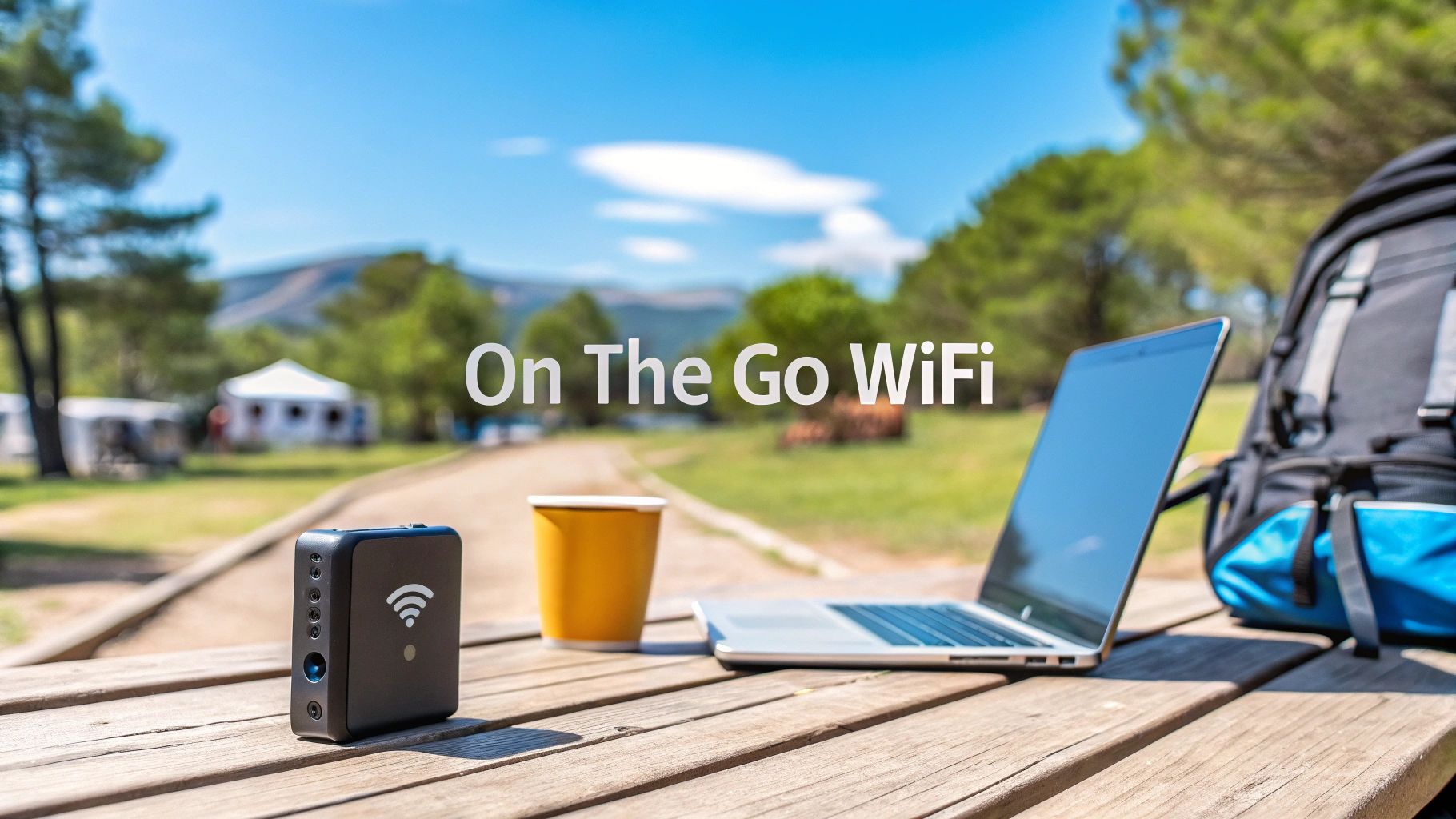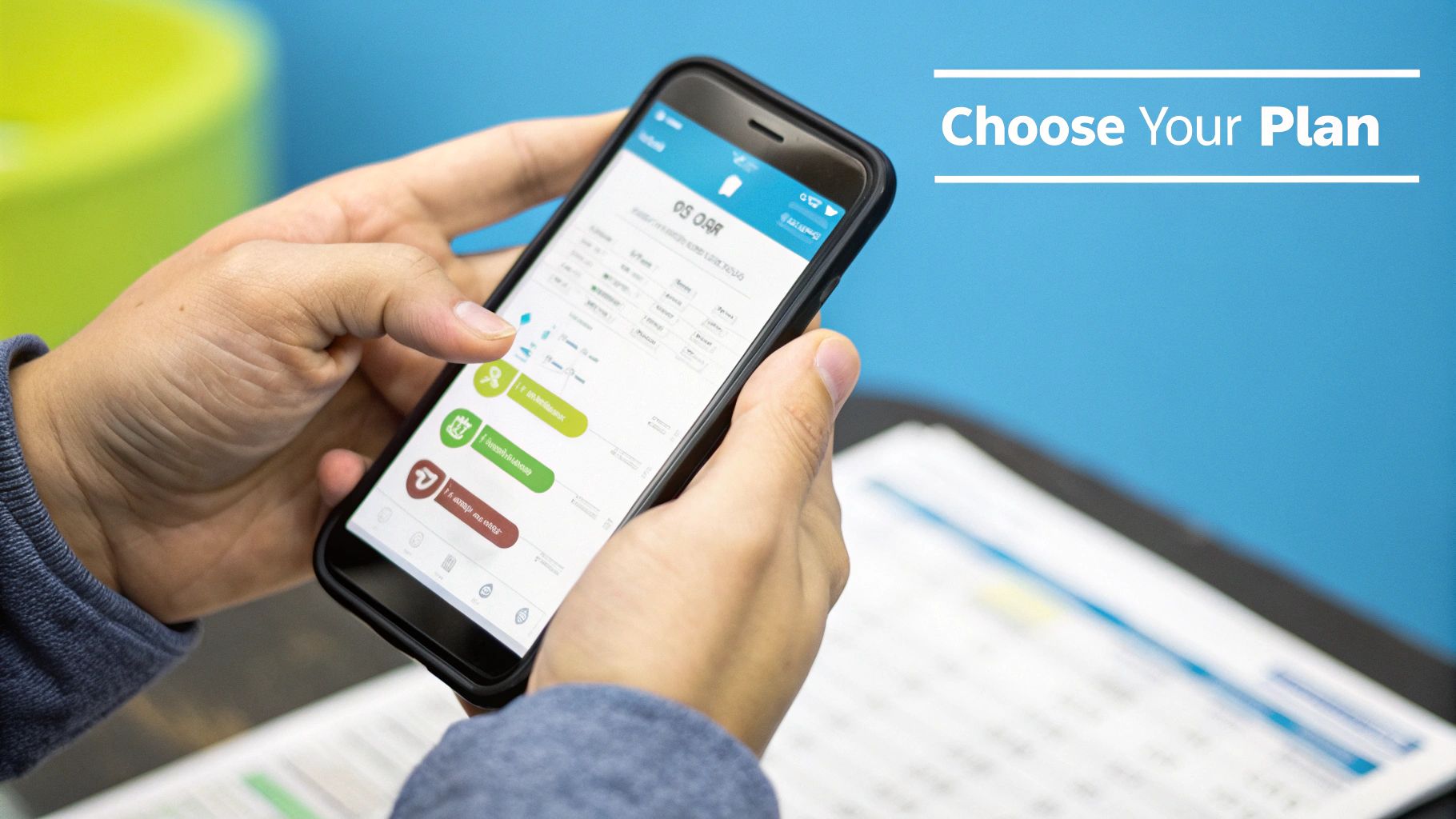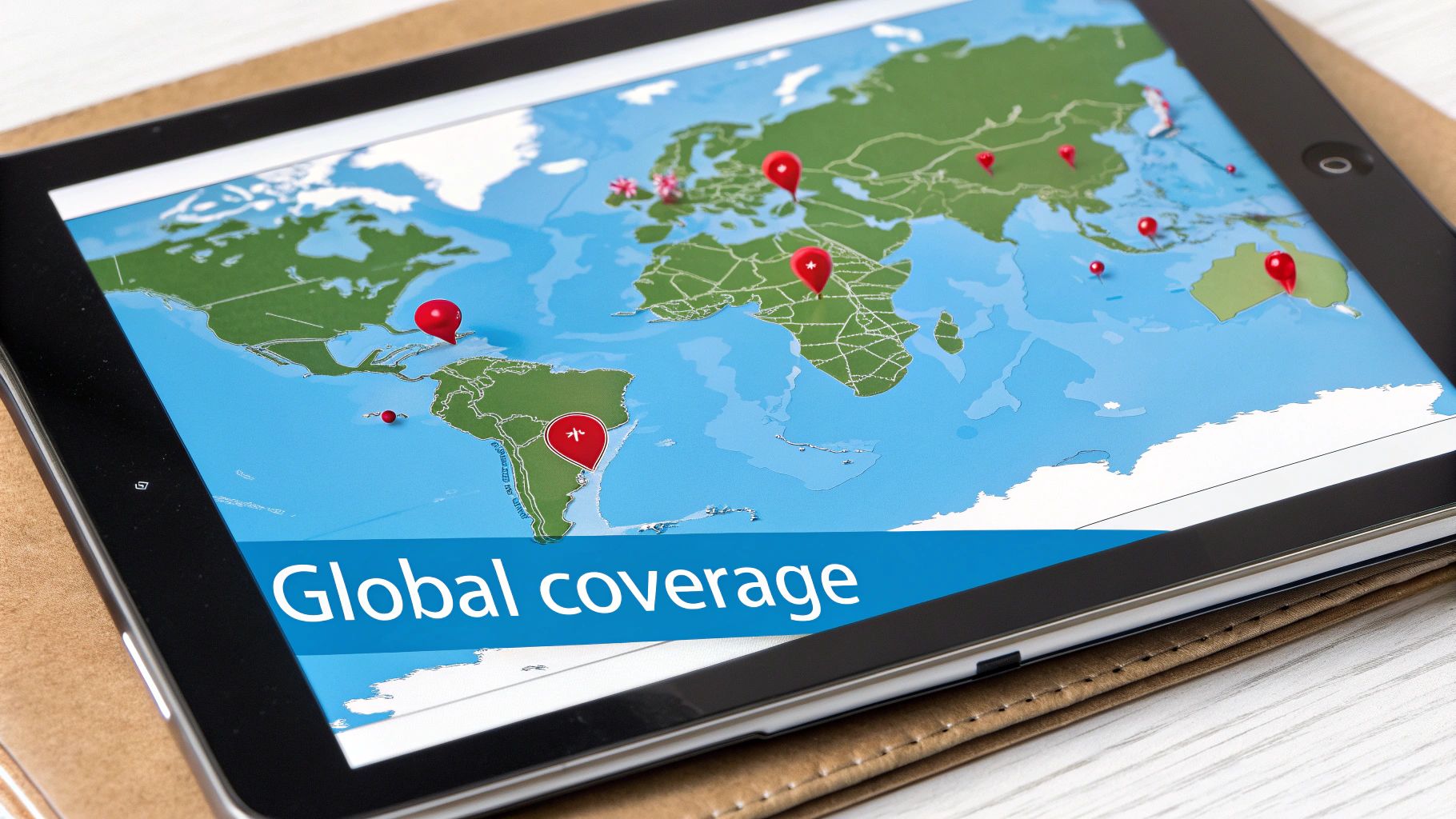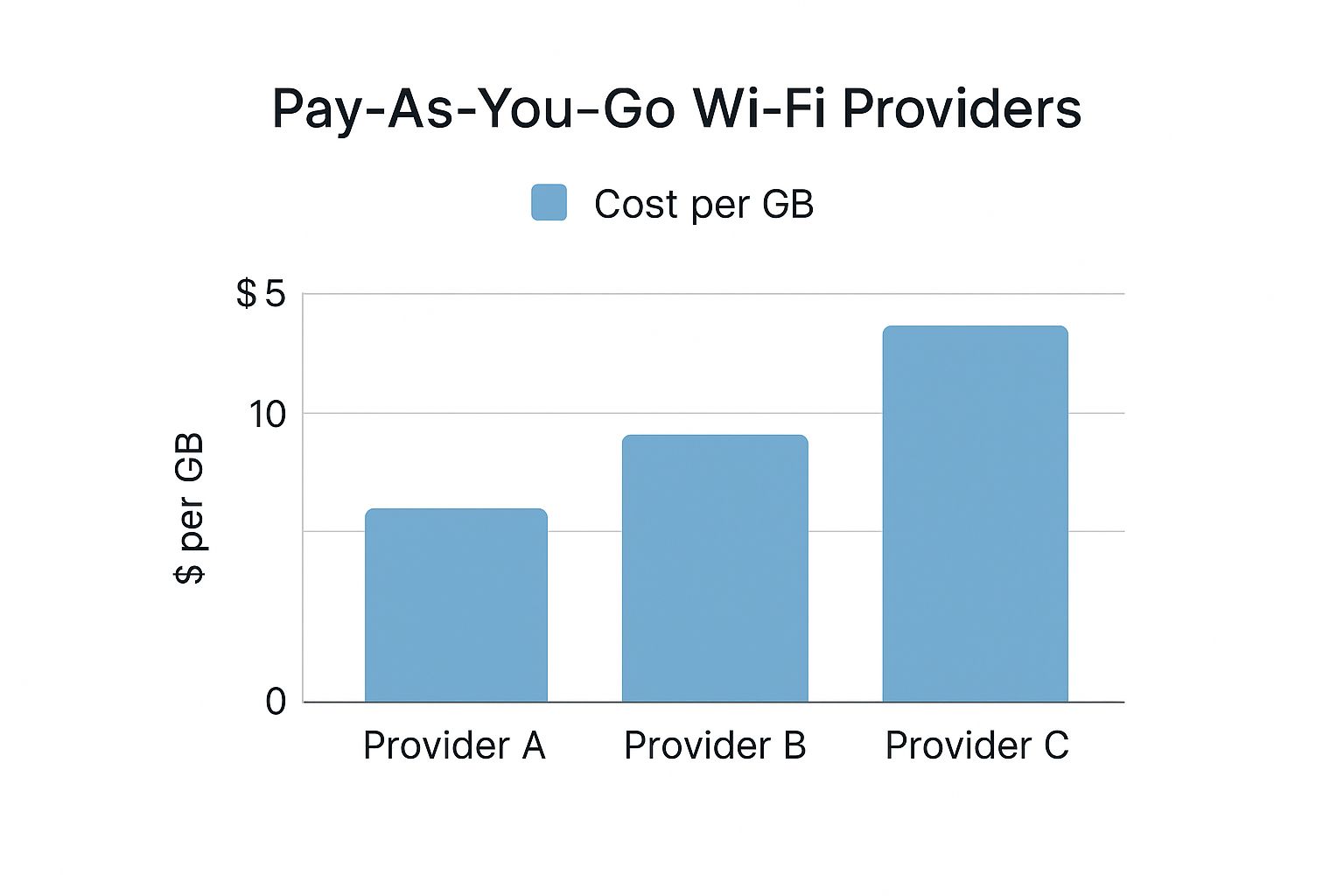

· By James
Your Guide to WiFi On The Go Pay As You Go
We've all been there—staring at that dreaded 'No Internet Connection' screen right when we need it most. If you're on the move, that frustration can be a constant battle. WiFi on the go pay as you go is the perfect answer.
Think of it like a prepaid phone plan, but for your laptop, tablet, or whatever other gadgets you travel with. You get a reliable internet connection almost anywhere, but you only ever pay for the data you actually need. No contracts, no long-term commitments, and no surprise bills at the end of the month.
Your Guide to Internet Freedom Without the Contracts

Are you tired of being locked into expensive internet contracts and paying for service you don't even use half the time? The whole idea behind pay-as-you-go WiFi is simple: it puts you back in the driver's seat. Instead of a fixed monthly bill, you buy a chunk of data upfront, giving you the freedom to get online whenever and wherever you need it.
This kind of flexibility is a lifesaver in so many situations. Maybe you're a seasonal RVer who only hits the road in the summer, a digital nomad bouncing between cities, or just someone who wants a solid backup internet plan for when the home connection inevitably goes down. The real beauty is that you stop paying for idle time, which is a major downside of traditional plans.
Who Benefits Most From This Flexibility?
While no-contract internet is great for a lot of people, it's absolutely transformative for a few specific groups. For anyone chasing location independence, like learning how to become a virtual assistant, having reliable mobile internet isn't just a perk—it's what makes the whole lifestyle possible. The power to work from anywhere without constantly hunting for a decent public WiFi signal is a total game-changer.
Here’s a quick look at who stands to gain the most:
- RVers and Van-Lifers: Pay for data only when you're traveling. When the rig is parked for the off-season, you're not spending a dime.
- Frequent Travelers: Stay connected in hotels, airports, and at client sites without having to trust unsecured, spotty public networks.
- Rural Residents: Finally get access to high-speed internet in places where traditional broadband is either painfully slow or just doesn't exist.
- Remote Workers: A dependable backup connection means you can shrug off a local outage and prevent costly downtime.
This shift toward flexibility is completely reshaping the market. It's not a niche product anymore; it's become a mainstream solution for people who want total control over their connectivity and their budget.
The numbers back this up. The market for Wi-Fi hotspot services—a huge part of on-the-go internet—was valued at roughly $4.4 billion in 2023. It’s projected to explode to $16.5 billion by 2033. That incredible growth is being fueled by pay-as-you-go models that cater directly to travelers, remote professionals, and anyone who's done with binding contracts.
This guide will break down all the popular options out there. We'll look at everything from pocket-sized mobile hotspots to dedicated data-only SIM cards to help you find the perfect setup for your needs.
How On-Demand Internet Actually Works

So, how does this all come together? Let's pull back the curtain on how these portable internet solutions get you online.
Think of it like having a personal power generator, but for your internet connection. You fuel it up with a data plan, and whenever you need a signal, you just fire it up. That’s the simple idea behind wifi on the go pay as you go systems.
The magic happens inside a dedicated device, usually a mobile hotspot. This little gadget, often small enough to fit in your pocket, is a brilliant translator. It catches a powerful cellular signal—the same 4G LTE or 5G your smartphone uses—and transforms it into a private, secure WiFi network just for you.
This personal WiFi bubble is what lets your other devices, like laptops, tablets, or even a smart TV, connect to the internet without needing their own cellular plans. It’s a straightforward but incredibly effective way to create your own internet oasis, no matter where you've parked for the night.
The Two Key Components: Hardware and Data
To really get it, you just need to understand the two main parts of the system: the physical device creating the signal and the data plan that fuels it.
1. The Hardware: The Signal Creator
The most common piece of gear you'll see is a mobile hotspot, sometimes called a MiFi device. This is the engine of your whole setup.
Inside, it has a SIM card slot, just like your phone. You pop in a SIM card from a data provider, and the hotspot is ready to talk to that provider’s cellular network.
A mobile hotspot is basically a specialized router that doesn’t need a cable plugged into the wall. Instead of getting internet from a phone jack, it pulls its connection right out of the air using cell towers. This gives you a reliable signal whether you’re in an RV, a remote cabin, or just a coffee shop with spotty service.
2. The Fuel: The Data Plan
This is where the "pay as you go" freedom really shines. Instead of getting locked into a monthly contract, you buy data in chunks. It’s like filling up your RV’s gas tank—you just buy what you think you'll need for the journey ahead.
When your data runs low or the plan expires, you simply "top up" with more. No fuss, no long-term commitment.
How You Top Up Your Data
Reloading your data is designed to be painless, putting you in complete control of your spending and connectivity. You're never caught off guard.
The whole process is built for convenience, making sure you can add more data whenever you need it. The most common ways to do this are:
- Provider's App or Website: Most services have a user-friendly online portal or a mobile app. You can log in, see exactly how much data you have left, and buy a new pass with just a few taps.
- Prepaid Data Cards or Vouchers: You can often find physical data cards at retail stores. Just buy a card, scratch off the code, and enter it online to instantly add the data to your account.
- Automatic Renewal (Optional): If you find a plan you love but still don't want a contract, many services let you set up an auto-renew. It gives you consistency, but you still have the freedom to cancel it anytime.
This on-demand model is perfect for travelers because it eliminates waste. If you’re an RVer who parks your rig for six months out of the year, you’re not paying a dime for internet during that downtime. The moment you're ready to hit the road again, just buy a data plan, and you're instantly back online with the same device.
Choosing Your Ideal Pay-As-You-Go Wi-Fi Setup

This little gadget is a Verizon Jetpack MiFi X Pro 5G. It's a great example of the powerful mobile hotspots that act as the engine for a solid pay-as-you-go Wi-Fi on the go setup. Think of it as your personal internet bubble, catching cellular signals and turning them into Wi-Fi for all your devices.
But finding the right setup isn't as simple as grabbing the first device you see. It's a two-part puzzle: you have to match the hardware with a data plan that actually fits how you live and travel. The goal is a reliable connection that doesn't burn a hole in your wallet. The best choice for a weekend camper is going to look completely different from what a full-time digital nomad needs.
And more people are trying to solve this puzzle every day. The global market for portable Wi-Fi was worth about $8.6 billion in 2023, and it's expected to blow past $25.8 billion by 2032. That's a huge jump, and it’s all because more of us—travelers, remote workers, and anyone juggling multiple smart devices—are demanding flexible, reliable internet.
Evaluating The Hardware: The Hotspot Device
So, let's talk about the hardware. A mobile hotspot is basically your personal signal translator. Its main job is to grab a cellular signal out of the air and turn it into a strong Wi-Fi network for your laptop, phone, or tablet. When you're comparing different models, a few key features really make a difference in your day-to-day experience.
-
Battery Life: For true portability, a long-lasting battery is non-negotiable. I always look for hotspots that can give me a full day of use—at least 8-12 hours—on a single charge. There’s nothing worse than your internet dying mid-Zoom call just because you aren't near an outlet.
-
Device Connections: How many gadgets are you bringing along? A basic hotspot might only handle 5-10 devices at once, which is plenty for a solo traveler. But if you’re trying to connect laptops, phones, and tablets for the whole family or a work team, you’ll need a more robust model that can support 15-30 devices without grinding to a halt.
-
Network Compatibility (4G vs. 5G): This really comes down to your need for speed. A 4G LTE hotspot is perfectly fine for everyday tasks like browsing the web, checking emails, and even streaming video in standard definition. But if you're doing anything more demanding—like HD video conferencing, downloading huge files, or online gaming—a 5G-capable device is a much better investment. Where 5G is available, you'll get significantly faster speeds and a more responsive connection.
Decoding The Data Plan: The Fuel for Your Connection
Once you've got your eye on the right piece of hardware, it’s time to pick the fuel that makes it run: the data plan. This is where the "pay-as-you-go" model really shines, but you have to read the fine print to find the best value for your money.
A cheap data plan isn't a good deal if it runs out halfway through your trip or doesn't work where you need it most. The best plan is one that aligns perfectly with your usage habits, travel destinations, and budget.
When you're comparing plans, look past the sticker price and dig into these crucial factors:
-
Data Allotment: First, be honest with yourself: how much data do you actually use? Plans can range from a few gigabytes (like 5GB) for light users all the way up to massive 100GB or more packages for remote workers or heavy streamers. A good trick is to check your data usage on your phone for a month to get a realistic baseline.
-
Validity Period: This is simply how long your data lasts before it expires. Some plans reset every 30 days, while others might give you 60 or 90 days. If you travel infrequently, a longer validity period is fantastic because you won't lose your unused data just because a new month rolled around.
-
Carrier Coverage: A great plan is completely useless if you can't get a signal. Always, always check the provider’s coverage map to make sure they have a strong signal in the specific areas you plan to visit. This is absolutely critical for anyone heading to rural or remote spots. For a deeper look at this, our guide on internet for RV living has some great tips on checking coverage for life on the road.
-
Throttling Policies: Watch out for so-called "unlimited" plans with hidden catches. Many carriers will dramatically slow your connection—a practice called throttling—once you hit a certain data cap, sometimes making it almost unusable. Dig into the fine print and find the "premium data" limit so you know exactly what you're paying for.
Finding The Best WiFi for RV Life and Rural Areas
For anyone living or traveling far from the city, reliable internet isn't just a nice-to-have—it's a lifeline. A little pocket hotspot that works just fine in a bustling downtown can quickly become a paperweight once you’re surrounded by mountains or rolling farmland. This is exactly where a more serious approach to wifi on the go pay as you go becomes a game-changer for RVers and folks in rural areas.
These users need more than the ability to check email. They're often running a remote business, streaming movies after a long day, or video-calling family from areas with spotty cell service at best. This requires stepping up from basic portable gadgets to a more powerful system of mobile routers and signal-boosting gear.
Building a More Powerful Mobile Setup
When your RV is your home office or you live miles from the nearest cell tower, your internet setup needs to be a real workhorse. The heart of this system is a high-performance mobile router. Think of it less like a travel gadget and more like your home router, only it gets its internet from a cellular network using a SIM card.
But a great router is only half the battle. To really pull in a signal, these routers are paired with specialized antennas. It's like this: a standard hotspot has a tiny, built-in antenna, kind of like the old rabbit ears on a TV. For remote areas, you need a big, powerful antenna mounted on the roof of your RV or house to grab distant signals your phone can't even see.
The key pieces for a rock-solid rural or RV setup include:
- High-Performance Mobile Routers: These are built for 24/7 use, handling multiple devices, and offering better security and stability than a simple hotspot.
- External High-Gain Antennas: Mounted outside, these antennas are designed specifically to capture weak cellular signals from miles away, making a huge difference in speed and reliability.
- Carrier Diversity: Pro users often keep SIM cards from multiple carriers (like Verizon, AT&T, and T-Mobile) on hand. This lets them switch to whoever has the strongest signal wherever they happen to be parked.
A common myth is that if your phone shows "No Service," you're out of luck. The truth is, a good external antenna can often pull in a usable signal where your phone gets nothing, simply because it's bigger and better at capturing those faint, distant radio waves.
The Art of Coverage Research
For anyone relying on mobile internet off the beaten path, the most important skill you can develop is learning how to research cell coverage before you go. The world's best data plan is useless if there isn't a cell tower for 50 miles. This is where coverage maps become your absolute best friend.
Before you head to a new campsite or look at a rural property, you have to dig into the coverage maps for all the major carriers. Don't just glance at the state—zoom way in on your specific location or travel route. Websites like CoverageMap.com or the maps on the carriers' own sites are essential tools. For RVers, our complete guide on how to get WiFi in an RV dives even deeper into planning your connectivity on the road.
When you're looking at the maps, pay close attention to the kind of coverage listed:
- 5G Coverage: This is the fastest you can get, but it's still mostly found in and around cities and towns.
- 4G LTE Coverage: This is the workhorse network. It's the most widespread high-speed connection and the backbone of mobile internet for most travelers.
- Partner Coverage: This means you'll be "roaming" on another company's towers. That can sometimes mean slower speeds or different rules for how you can use your data.
Finally, you need to prioritize providers known for having strong rural networks. One carrier might dominate the cities, but another is often the undisputed king of the countryside. When you match a provider with a great rural footprint to a high-data pay-as-you-go plan, you get the powerful, flexible connection you need to live and work from anywhere.
Comparing the Top Pay As You Go WiFi Providers
Alright, you've got the hardware and data plans figured out. Now it's time to put the major players side-by-side. Choosing the right provider for your wifi on the go pay as you go setup is about way more than just grabbing the cheapest plan. It’s about finding the best all-around value for how you travel. A rock-bottom price is totally worthless if the network coverage is a dead zone where you want to be.
We're going to break down the top providers, but we'll focus on the details that really matter on the road. Things like the true cost per gigabyte of data, what you'll pay upfront for hardware, which cellular network they piggyback on, and how long you have to use the data you buy.
This approach helps you see the real-world pros and cons. One service might have the lowest data cost but be spotty in rural areas. Another might be pricier but deliver the kind of solid, reliable speed you need for remote work.
Analyzing the True Cost of Data
The easiest way to cut through the marketing fluff is to look at the cost per gigabyte (GB). It’s a simple metric that shows you exactly what you're paying for your data.
Here's a quick visual that shows why this matters. It compares three hypothetical providers and is a great way to start any comparison.

As you can see, Provider A is the most budget-friendly per gigabyte. Provider C, on the other hand, is double the cost. That suggests it needs to bring something else to the table—like better coverage or premium features—to justify that higher price tag.
The good news is that this market is booming thanks to a massive infrastructure build-out. Back in 2015, there were about 47.7 million Wi-Fi hotspots around the world. In the next five years, that number was projected to explode to over 340 million—that’s about one hotspot for every twenty people on the planet. This rapid expansion makes pay-as-you-go options more practical than ever before. You can discover more insights about the Wi-Fi hotspot market on grandviewresearch.com.
A Detailed Provider Comparison
Now, let's move from hypothetical charts to how real-world providers actually stack up. The table below breaks down some popular options to help you match a service to your needs, whether you're a weekend camper or a full-time digital nomad.
When you look at this table, think about your own travel and data habits. A plan with a 90-day expiration might be perfect for an occasional trip. But if you're on the road full-time, you'll care a lot more about the cost per gigabyte and how well the network performs in those beautiful, remote spots.
Comparison of Pay As You Go WiFi Providers
Here’s a look at some of the most popular pay-as-you-go data providers for travelers. I've focused on the key details you'll need to make a smart choice for your mobile internet setup.
| Provider | Network Used | Example Plan (Data/Price/Validity) | Hardware Cost | Pros | Cons |
|---|---|---|---|---|---|
| SwiftNet | AT&T, Verizon | 100 GB / $80 / 30 Days | $199 - $399 | Excellent rural coverage, high data caps for heavy users, flexible plans. | Higher initial hardware cost. |
| TravlFi | Multiple Carriers | 25 GB / $35 / 30 Days | $150 - $220 | Automatically switches between carriers for the best signal. | Can be more expensive for large data packages. |
| Solís | Multiple Carriers | Unlimited Daypass / $8 | $160 | Excellent for international travel with global daypasses. | Pay-per-day model can get expensive for long-term domestic use. |
| Visible | Verizon | Unlimited Data / $25/mo | Bring Your Own | Extremely low cost for unlimited data on Verizon's network. | Speed capped at 5 Mbps, officially for one device only. |
Ultimately, the "best" provider is the one that fits your budget, travel style, and data consumption. A full-timer's needs are vastly different from someone who just needs to check emails on a two-week road trip, so use this as a starting point to find your perfect match.
Common Questions About Pay As You Go WiFi
When you start digging into flexible internet options, a few questions always pop up. It's smart to ask them, and getting clear, straightforward answers is the only way to feel confident about your choice. Let's walk through the most common things people wonder about when they're considering wifi on the go pay as you go solutions.
We'll tackle these one by one to give you a solid understanding of what to expect.
Can I Just Use My Smartphone as a Hotspot?
Tethering to your smartphone is definitely handy in a pinch, but for any kind of regular use, it's a solution that comes with some serious drawbacks.
The first thing you'll notice is the battery drain. Running a hotspot can suck your phone's battery dry 2-to-3 times faster than normal. Suddenly, your primary lifeline for calls and navigation is dead when you might need it most.
Beyond that, most cell phone plans are surprisingly strict about hotspot data. Even so-called "unlimited" plans often have a separate, much smaller data cap for hotspot usage. Once you hit that limit, carriers will slow your speeds to a crawl, making it almost useless for anything important. A dedicated mobile hotspot, on the other hand, is built for one job: delivering a steady, reliable internet connection for your other devices. That’s why it's the go-to for anyone serious about working or traveling without being tied down.
Is the Internet Speed Fast Enough for Streaming and Video Calls?
Absolutely. The speeds you'll get from a good pay-as-you-go hotspot are powered by the same cellular networks your phone uses—and they're more than up to the task.
Most modern hotspots tap into 4G LTE or even 5G networks, which provide plenty of bandwidth for demanding activities. A solid 4G LTE signal is all you need for smooth HD movie streaming, seamless video meetings, and lag-free web browsing. If you get a 5G-capable device and you're in a 5G area, your speeds can easily beat what many people get from their home internet.
Of course, your signal strength will always depend on your distance from the nearest cell tower and how busy the network is. But a quality hotspot is designed to make the most of the available signal. If you're worried about burning through data on all those Zoom calls, it's a good idea to learn how to reduce data usage to get the most out of your plan.
What Is an Unlocked Mobile Hotspot?
This one is a game-changer, and understanding it is the key to real flexibility. A "locked" hotspot is a device sold by a carrier (like Verizon or AT&T) that will only work with their SIM cards. You're stuck with them.
An "unlocked" mobile hotspot, on the other hand, is carrier-agnostic. Think of it like an unlocked smartphone—you have the freedom to pop in a SIM card from almost any provider that's compatible. For travelers, this is pure gold.
This freedom means you can:
- Switch carriers when you're at home to find the best signal or a better deal in your area.
- Buy local SIM cards when you travel to other countries, completely sidestepping those outrageous international roaming fees.
An unlocked device puts you in the driver's seat. You get to shop around for the strongest signal and the best price, ensuring your wifi on the go pay as you go setup is as powerful and affordable as it can possibly be.
Wrapping It Up: Your Newfound Internet Freedom
We've covered a lot of ground, from pocket-sized hotspots to serious setups for life off the grid. If there’s one big idea to walk away with, it’s this: you are officially in the driver's seat of your internet connection. The days of being locked into rigid, one-size-fits-all contracts are over.
Choosing a flexible, on-the-go plan isn't just about trimming a monthly bill. It’s about unlocking the freedom to work, travel, and live without being chained to a cable or a long-term commitment you can't get out of.
A Smarter Way to Stay Connected
Think about it—the old way of getting internet was built to keep you in one spot. Pay-as-you-go internet is designed for a life in motion. It bends to fit your plans, not the other way around.
This shift in thinking opens up possibilities for all kinds of people:
- For the weekend warrior or traveler: It means having a secure connection in a new city without having to hunt for sketchy public Wi-Fi.
- For the full-time RVer: It’s the power to fire up high-speed internet during your travel season and completely pause the service during the off-season. That can easily save hundreds of dollars a year.
- For the remote worker: It’s a rock-solid backup plan, ensuring a sudden home internet outage doesn't derail your workday.
The real magic is simple: you only pay for what you actually use, when you need it. This completely cuts out wasted spending and gives you the agility to scale your data up or down on a whim.
Now you have the know-how to step into this world with confidence. You understand the gear, you can make sense of the data plans, and you have a game plan for finding a signal, even when you're way out there.
You're no longer just buying an internet service; you're designing your own connectivity. With that power, you can finally pick the right on-the-go solution that truly fits your journey and keeps you connected on your own terms, wherever the road takes you.
Ready to cut the cord and experience true internet freedom? SwiftNet Wifi offers high-speed 5G and 4G LTE internet solutions perfect for RV life and rural areas, with flexible plans that put you in control. Explore your options at SwiftNet Wifi.

